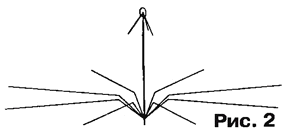The article al Cristman, K3LC (QST, Oct. 2000, p. 43 - 49) describes several unusual umbrella antenna to a range of 160 m, which can easily to be converted to other Amateur bands. The antenna has a number of advantages: firstly, its height does not exceed half the height of normal quarter-wave vertical antenna, i.e. is only λ/8, and secondly, vertical mast antenna grounded at the bottom, without requiring reference insulator, thirdly, the antenna power is at the top of the mast, allowing you to place virtually along its entire length, other structures, for example, the high-frequency antenna and УSW ranges. Two such mediumwave antenna built in Pennsylvania and successfully used for radio broadcasting.

By construction, the antenna follows the well-known 30-ies of the last century the antenna mast with top nutrition Eisenberg. It requires a good ground connection, and better - radial system balances. In Fig. 1 shows a diagram of the antenna with 120 buried at a shallow depth of a quarter-wave counterweight. All of them connected to the base of the mast height 21,33 m Coaxial cord runs inside the mast, his braid connects to the top of the mast, and the Central conductor - "umbrella". The latter is made of three wires with length of 14.2 m, inclined at an angle of 30° to the horizontal. These wires are the top stretch marks that support the mast. Stretching toward the ends of the buried balances.
The diameter of all the wires (balances and umbrella) - 2 mm Wire of copper or bronze antenna cord. The counterweight can be made of galvanized steel. The mast is a two-inch (diameter 50.8 mm) dural tube and rests on a half-inch galvanized steel pipe 1.5 m stuck in the ground.
Computer modeling has shown that this antenna is almost full-size the quarter-wave vertical with a similar system of checks and balances, is the gain relative to an isotropic radiator 1,26 dBi, the angle of maximum radiation in the vertical plane 24° and the input resistance (in power point) about 30 Ohms at the resonant frequency 1830 kHz. The dielectric constant of the earth relied equal to 13, the conductivity - 5 ICES/m.
Not stopping at many intermediate options, described in the article, we will tell you about the following: if the length of the buried balances reduce to 21 m, the gain of the antenna decreases to 0.24 dBi, i.e. by 1 dB, and the length of the rays "umbrella", which now is directed at an angle of 45° to the horizontal, it is necessary to increase to 15.4 m (for tuning of the resonance).

Because the creation of such an extensive "land" is problematic, was it is appropriate to use the raised balances, and in much smaller quantity. In Fig. 2 shows an embodiment with eight radial balances extending from the base of the mast to a height of 3.66 m, and then horizontally, the distance of 21.3 metres from the mast. Three wire "umbrella", is inclined at an angle of 45°, have a length of 15,66 M. the gain of the antenna fell by 0.7 dB and amounted -0,43 dB at input resistance of 23 Ohms.
Short raised balances require adjusting. To do this, the base of the mast they are connected by four together and connected to the mast using two coils with inductance 7 µh. The connection of the counterweight mast is not in the earth, and a certain height, a waiver of tuning coils or strip directly on the surface of the earth gives the worst results, sometimes a few decibels.
In the manufacture of the antenna, the author warns, you should pay the most close attention to the quality of electrical connections from them in a strong on the losses in the antenna. At the same time, the antenna mast must not necessarily to be aluminum - using galvanized iron loss increases less than 0.1 dB. Not necessarily to follow the size - the mast can be slightly above or below, and in the resonance antenna is configured by changing the length of the rays "umbrella". They can also be three or more. Raised balances better to set separately the change in inductance coils included in the base.
Very interesting are the results of computer simulation of antenna fairamoa the lattice of four umbrella antennas placed at the corners of a square with side 1/4 of the wavelength. Work pattern is not worse than the two-, three-element "wave channels" on HF bands. Achievable winnings exceeds 6 dB, and the ratio of the radiation power of forward/backward - 23 dB. Max radiation is still emitted at an angle of 22...23° to the horizontal.






